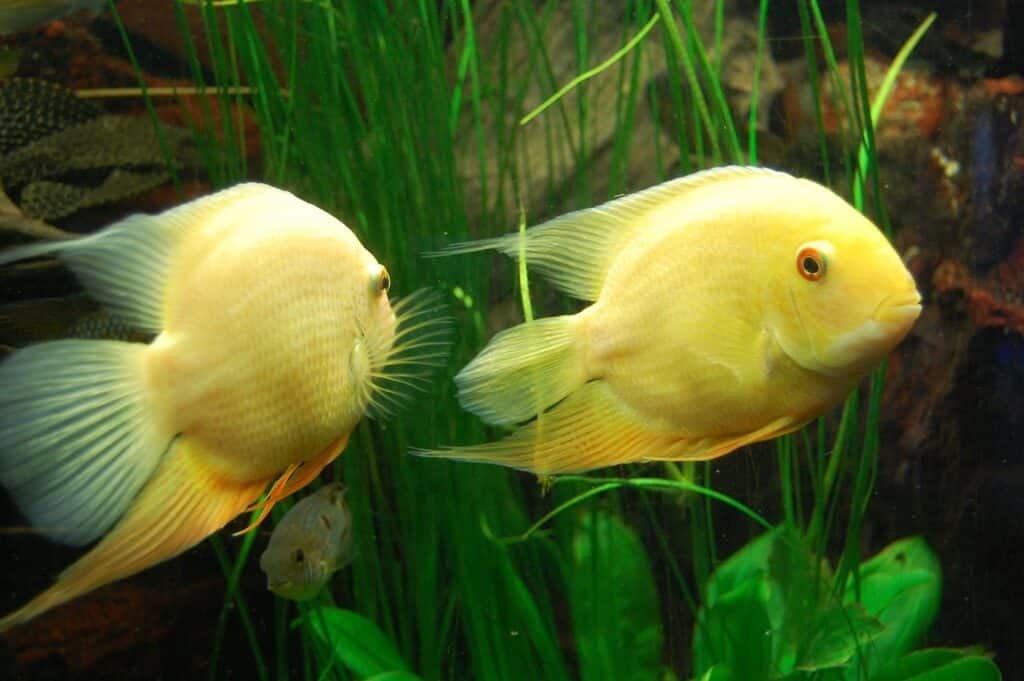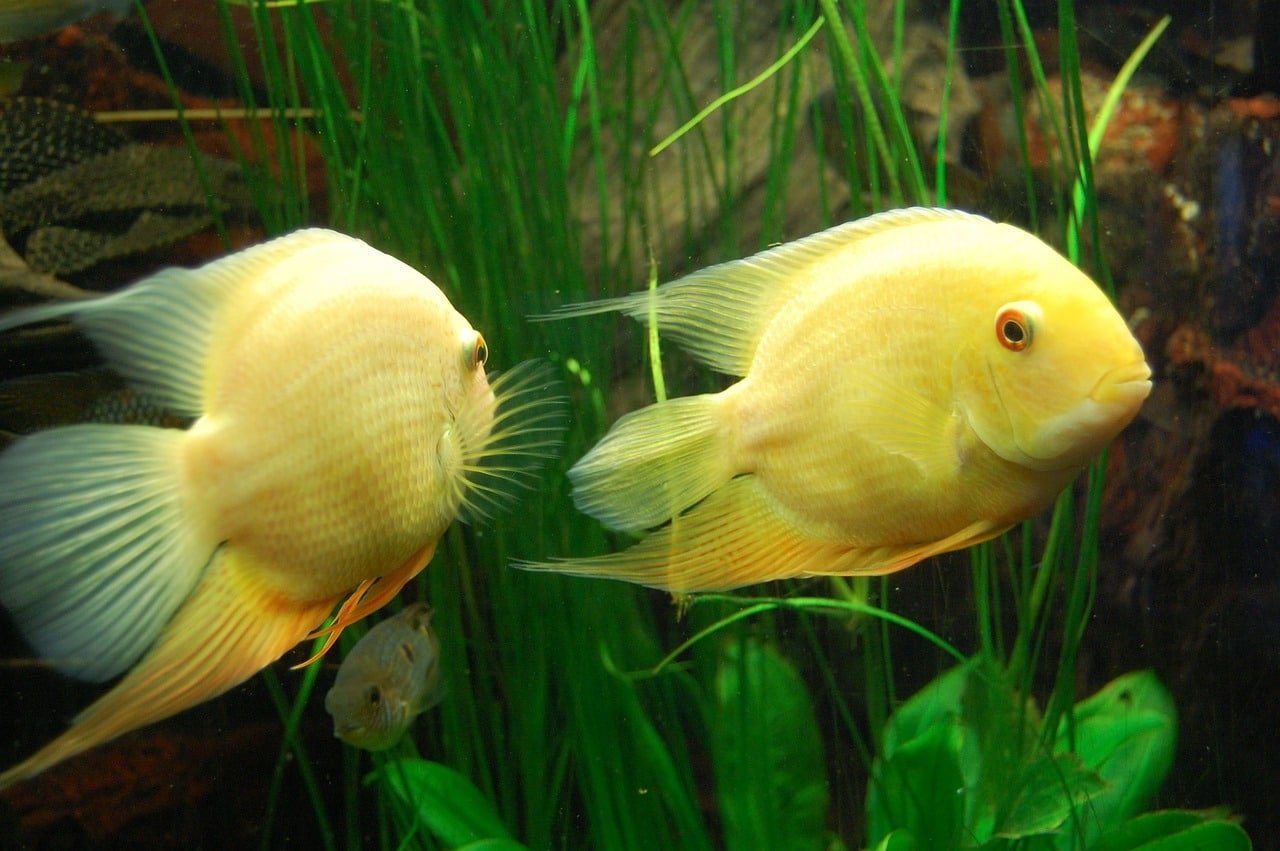The Turquoise Severum Cichlid, scientifically known as Heros efasciatus, is a captivating freshwater fish that boasts a vibrant turquoise coloration and a peaceful temperament, making it a popular choice among aquarium enthusiasts. In this comprehensive guide, we will delve into everything you need to know about the Turquoise Severum Cichlid, including their physical characteristics, habitat requirements, diet, tank mates, and more.
| Category | Details |
|---|---|
| Scientific Name | Heros efasciatus |
| Common Name | Turquoise Severum Cichlid |
| Coloration | Turquoise and blue hues with iridescent scales |
| Body Shape | Oval-shaped with long, flowing fins |
| Size | Typically up to 8 inches (20 cm), occasionally up to 10 inches (25 cm) |
| Natural Habitat | Slow-moving rivers and streams of the Amazon Basin in South America |
| Minimum Tank Size | 55 gallons for a single Severum, 75-100 gallons for pairs or community setups |
| Substrate | Sand or fine gravel |
| Decor | Driftwood, rocks, caves, live plants (e.g., Java Fern, Anubias) |
| Temperature | 75-84°F (24-29°C) |
| pH | 6.0-7.5 |
| Water Hardness | 4-15 dGH |
| Filtration and Aeration | Strong filtration system, regular water changes (20-30% weekly) |
| Staple Foods | High-quality cichlid pellets or flakes |
| Supplementary Foods | Live or frozen foods (e.g., brine shrimp, bloodworms, daphnia) |
| Vegetables | Blanched spinach, peas, zucchini |
| Feeding Frequency | 2-3 times a day |
| Compatible Tank Mates | Blue Acara, Keyhole Cichlids, Corydoras, Plecos, Congo Tetras, Buenos Aires Tetras, Pearl Gouramis, Three-spot Gouramis |
| Incompatible Species | Small Tetras, Guppies, aggressive cichlids (e.g., Oscars, Jack Dempseys), fragile species (e.g., Discus, Angelfish) |
| Breeding Behavior | Substrate spawners, both parents guard and fan the eggs |
| Fry Diet | Initial: Infusoria or fry food; Transition: Crushed flakes or brine shrimp |
| Common Diseases | Ich, Fin Rot, Hole-in-the-Head Disease |
| Preventative Measures | Maintain optimal conditions, varied diet, regular water changes |
| Color Variations | Shades of green, blue, yellow; enhanced by diet rich in carotenoids |
| Purchasing Sources | Local fish stores, online retailers, breeders |
| Cost | Juveniles: $10-$20; Adults: $20-$40 |
Physical Characteristics
The Turquoise Severum Cichlid is renowned for its striking appearance. Key features include:
- Coloration: A mesmerizing blend of turquoise and blue hues with iridescent scales.
- Body Shape: Oval-shaped body with long, flowing fins.
- Size: Typically grows up to 8 inches (20 cm) in captivity, though they can occasionally reach up to 10 inches (25 cm) with optimal care.
Their vibrant coloration and graceful movements make them a standout addition to any aquarium.

Natural Habitat
In the wild, Turquoise Severum Cichlids are native to the slow-moving rivers and streams of the Amazon Basin in South America. They thrive in warm, slightly acidic waters with plenty of vegetation and hiding spots. Replicating these conditions in your aquarium is crucial for their health and well-being.
Tank Setup
Tank Size
To accommodate the Turquoise Severum Cichlid’s size and activity level, a spacious tank is essential:
- Minimum Tank Size: 55 gallons for a single Severum.
- Larger Tanks: 75-100 gallons for pairs or community setups.
Substrate and Decor
- Substrate: Sand or fine gravel.
- Decor: Driftwood, rocks, and caves provide essential hiding spots and territory boundaries. Live plants such as Java Fern and Anubias are also recommended, as they can withstand the Severum’s occasional nibbling.
Water Parameters
Maintaining stable water conditions is vital:
- Temperature: 75-84°F (24-29°C).
- pH: 6.0-7.5.
- Hardness: 4-15 dGH.
Filtration and Aeration
A strong filtration system is necessary to keep the water clean and oxygenated. Regular water changes (20-30% weekly) are also crucial to prevent the buildup of harmful toxins.
Diet and Feeding
Turquoise Severum Cichlids are omnivores, requiring a varied diet to stay healthy:
- Staple Foods: High-quality cichlid pellets or flakes.
- Supplementary Foods: Live or frozen foods such as brine shrimp, bloodworms, and daphnia.
- Vegetables: Blanched spinach, peas, and zucchini.
Feed them 2-3 times a day, offering only what they can consume within a few minutes to avoid overfeeding and water quality issues.
Suitable Tank Mates
While Turquoise Severum Cichlids are generally peaceful, selecting compatible tank mates is crucial:
- Compatible Species: Blue Acara, Keyhole Cichlids, Corydoras, Plecos, Congo Tetras, Buenos Aires Tetras, Pearl Gouramis, Three-spot Gouramis.
- Incompatible Species: Small Tetras, Guppies, aggressive cichlids like Oscars or Jack Dempseys, and fragile species like Discus or Angelfish.
Breeding Turquoise Severum Cichlids
Breeding Turquoise Severum Cichlids can be a rewarding experience:
Spawning Behavior
- Substrate Spawners: They lay eggs on flat surfaces such as rocks or broad leaves.
- Parental Care: Both parents guard and fan the eggs to ensure proper aeration and protect them from potential threats.
Raising Fry
Once the eggs hatch, the fry can be fed:
- Initial Diet: Infusoria or specially formulated fry food.
- Transition: Gradually introduce finely crushed flakes or brine shrimp as they grow.
Regular water changes and close monitoring of water quality are crucial during this stage.
Health and Disease Prevention
Maintaining optimal conditions and a varied diet helps prevent common health issues:
Common Diseases
- Ich (White Spot Disease): Characterized by white spots on the body and fins. Treat with medication and increase water temperature slightly.
- Fin Rot: Caused by bacterial infections, often due to poor water quality. Improve water conditions and treat with antibacterial medications.
- Hole-in-the-Head Disease: Linked to poor diet and water quality. Improve nutrition and water conditions, and treat with appropriate medications.
Turquoise Severum Cichlid: Aesthetic Appeal
One of the main attractions of the Turquoise Severum Cichlid is its vibrant and dynamic coloration. The turquoise and blue hues of their scales can vary depending on their mood, diet, and overall health, making them a living piece of art in your aquarium.
Color Variations
While the primary coloration is turquoise, some individuals may exhibit shades of green, blue, and even hints of yellow, adding to their visual appeal. Ensuring a nutritious diet rich in carotenoids can enhance their natural coloration.
Purchasing Turquoise Severum Cichlids
When looking to add Turquoise Severum Cichlids to your aquarium, consider reputable sources:
Sources
- Local Fish Stores: Often have a variety of cichlids, including Turquoise Severums.
- Online Retailers: Many reputable online stores offer a wide selection of cichlids.
- Breeders: Buying from experienced breeders ensures you get healthy, well-cared-for fish.
Cost
The cost of Turquoise Severum Cichlids can vary:
- Juveniles: Typically range from $10 to $20.
- Adults: Can cost between $20 to $40, depending on size and coloration.
Severum Cichlid Colors and Varieties
Natural Color Variations
Severum Cichlids exhibit a range of natural color variations, often depending on their geographical origin and genetics. Common colorations include:
- Green Severum Cichlid: Displaying a greenish body with possible red or orange hues on the fins and face.
- Gold Severum Cichlid: A bright yellow or gold body with potential red markings on the fins.
- Red Severum Cichlid: Featuring red spots or patches, often on a green or yellow background.
- Rainbow Severum Cichlid: Care, Habitat, and Breeding
- Turquoise Severum Cichlid : Care, Habitat, and Breeding
- Blue Severum Cichlid: Care, Habitat, and Breeding
Conclusion
The Turquoise Severum Cichlid is a stunning and relatively easy-to-care-for fish that can bring vibrant color and life to your aquarium. By providing them with a spacious tank, suitable tank mates, a varied diet, and maintaining optimal water conditions, you can enjoy the beauty and personality of these remarkable cichlids for many years.
Whether you are a seasoned aquarist or a beginner, the Turquoise Severum Cichlid is a fantastic choice that will undoubtedly enhance your aquarium experience. Their peaceful nature, combined with their striking appearance, makes them a joy to observe and care for. So, if you are looking to add a splash of turquoise to your aquatic world, the Turquoise Severum Cichlid is the perfect choice.
Discover more from EMMOCEB
Subscribe to get the latest posts sent to your email.






